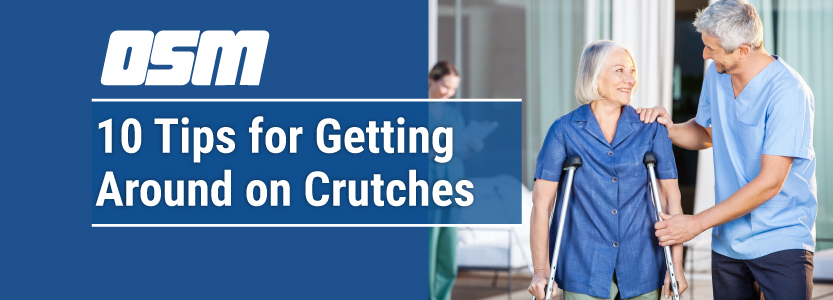10 Tips for Getting Around on Crutches
Article featured on Healthgrades
1. Verify Your Fit
Properly fitting crutches can make the difference between comfort and calluses. When you’re standing up straight with your arms at your side, the top of the crutches should be 1 to 2 inches below your armpit, and the handgrips should be at wrist-level. Your elbow should be slightly bent in this position. If your crutches don’t feel right after using them for a day or two, don’t hesitate to ask your care team for a different size.
2. Walk This Way
To walk, start standing up straight on your good leg with your crutches gripped in your hands. Lean onto your good leg, lift your crutches, and set them down 6 to 12 inches in front of your good foot. Lean your weight into your hands and step your good leg 6 to 12 inches in front of your crutches. Rest as necessary and repeat. Always look ahead—and not down—as you walk. Your body will follow your gaze.
3. Get a (Cushioned) Grip
Your hands—not your armpits—should bear your weight when you use crutches. If you push your crutches into your armpits, nerve damage could occur and send pain down your arms. If your hard-working hands become sore, cushion the handgrips with an adhesive pad. Or consider wearing fingerless gloves with padding if you need to walk a far distance.
4. Scan for Obstacles
You certainly don’t want to take a tumble while you’re on crutches and risk injuring another body part, like a wrist or your good leg’s ankle. While you’re walking, be on the lookout for ice patches, puddles, curled-up rug edges, gravel, and small steps. Think about how to safely and slowly get past your obstacle—or find another way to get where you’re going.
5. Use Care When Sitting
Sit down slowly every time. Transfer both crutches to the hand on the same side as your injured leg. Lean into your crutches, then reach back with your free hand to feel the chair, sofa, stool or bed. Sit down into the seat. Be sure to set your crutches down upside-down within reach. When standing up, slide to the edge of the your seat, and reverse these steps. Keep the back of your good leg touching the seat.
6. Sit Down on the Steps
If there’s an elevator to take you up and down floors, use it. But if you need to negotiate stairs on crutches, The American College of Foot and Ankle Surgeons recommends that you do so seated. That may feel odd, but it reduces your risk of a tumble and further injury. Be sure to push your crutches up or down in the direction you’re going before you start, so they’re available when you stand up again.
7. Contain Beverages and Foods
When you’re on crutches, carrying a cup of coffee or a sandwich to the couch can be a challenge without help. One way to do this on your own is to transport foods in closed travel containers, such as plastic containers or travel mugs. You can carry even more if you use a backpack or side-slung pack.
8. Equip Your Pad
You may spend more time at home than usual while your leg heals. So outfit your pad with props that save you time and effort. Use a wheeled office chair to roam the rooms of one level of your house. In the kitchen, set up a high, stable bar stool that you can lean on while you prepare food and drinks. And use (clean) trash grabbers or long barbeque tongs to pull small items down from tall shelves.
9. Care for Your Crutches
Once a week when you’re sitting down, check your crutches for anything that may weaken their support. Look for things like loose hardware, worn tips, and items like small rocks or stickers that have become lodged to the rubber ends. The more sturdy your crutches are, the more steady your pace will be.
10. Embrace Your Pace
You simply aren’t going to get around as quickly or as easily on crutches as you could before them. Give yourself plenty of time to get everywhere. And give yourself a pass on most of the items on your to-do list for a bit. The more slowly you go, and the more rest you give yourself and your injured leg, the more quickly you’ll regain strength and speed. And ultimately, you’ll recover quickly and safely.
The Orthopedic & Sports Medicine Center of Oregon is an award-winning, board-certified orthopedic group located in downtown Portland Oregon. We utilize both surgical and nonsurgical means to treat musculoskeletal trauma, spine diseases, sports injuries, degenerative diseases, infections, tumors and congenital disorders.
Our mission is to return our patients back to pain-free mobility and full strength as quickly and painlessly as possible using both surgical and non-surgical orthopedic procedures.
Our expert physicians provide leading-edge, comprehensive care in the diagnosis and treatment of orthopedic conditions, including total joint replacement and sports medicine. We apply the latest state-of-the-art techniques in order to return our patients to their active lifestyle.
If you’re looking for compassionate, expert orthopedic surgeons in Portland Oregon, contact OSM today.
Phone:
503-224-8399
Address
1515 NW 18th Ave, 3rd Floor
Portland, OR 97209
Hours
Monday–Friday
8:00am – 4:30pm




